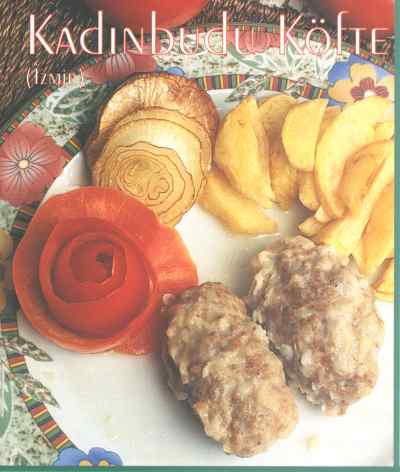
With a smattering of history --
and a grrreat! recipe...
In the years just prior to the First Crusade,
one man dominated the İzmir region -- then known as Smyrna.
He was Çaka bey (say chah-kah behy), the first in a long line of celebrated Turkish naval commanders that included Barbarossa (the warrior) and the Piri Reis (the map maker).
Çaka, a Selçuk Turk by birth, first joined Selçuk legions as a simple foot soldier --
fighting against the Byzantine Emperor Alexius Comnenus sometime after 1078 AD.
And in 1081, while Alexius was in the Balkans battling the Pechenegs,
Çaka seized the opportunity to establish his own small kingdom in ancient Smyrna --
already 2000 years old at the time.
The offshore islands presented rich and tempting targets,
so he built the first Turkish Navy and set sail --
first conquering Chios, then Samos and Rhodes.
And when Alexius sent his own navy to stop him, Çaka defeated it handily.
But the cunning Byzantine wasn't done yet --
and he conspired to create jealously between
the Selçuk Sultan Kılıç Arslan and his son-in-law Çaka.
After the two men faced off a couple of times,
Çaka was forced into an uneasy truce with the sultan.
And according to Byzantine sources, Çaka met His Maker at
an ostentatious dinner party given by Kılıç Arslan
(to observe renewed 'Selçuk solidarity')
during which the sultan spiked Çaka's 'punch' with deadly poison!
But fear not... The present-day İzmir 'food kitchen' is far from poisonous!
On the contrary, it offers the most easy-going of food menus. For example,
İzmirites often start the day with a breakfast of simple, sooo tasty
kaynarca (toasted day-old bread, doused with hot meat juices).
Lunch is never heavy (a light fish course suffices),
and dinner features a wide range of vegetables.
In the countryside, between meals, villagers savor snacks of
broad bean, collard greens and zucchini.
Those 'on diet' forego the snacks
and drink a mountain tea called
ana baba kokusu (mother and father's smell) --
found especially in the Alaouite Muslim villages.
Olive oil is much-loved and abundantly used in the region --
bread dipped in olive oil is often enough to
make a lip-smacking meal for local folk.
A boiled vegetable salad of
radika (wild-growing chicory)
is also extremely popular.
This is served cool
(with lots of olive oil, remember)
sometimes with unripened grapes,
sometimes with lemon juice.
But the dish that made İzmir's kitchen famous
is provocatively named kadınbudu; a woman's thigh...
--------------------------------------------------------------------------------
--------------------------------------------------------------------------------
Kadınbudu Köfte -- a 'shapely' ground-meat patty
Preparation time: 20 minutes
Cooking time: 40 minutes
--------------------------------------------------------------------------------
Köfte ingredients -- Serves 5
half-cup rice
1 tablespoon margarine
2 onions (finely minced)
500 gr. lean ground beef
half-teaspoon salt
half-teaspoon black pepper
Frying ingredients:
4 tablespoons flour
3 eggs
1 cup refined vegetable oil
--------------------------------------------------------------------------------
Preparation:
Clean the rice and cook in vigorously boiling water
for 20 minutes, then strain.
Lightly brown the onion in a tablespoon of vegetable oil.
Add half the ground beef and cook with the onion for 5 minutes.
When cool, put this mixture on a tray and
blend-in remaining ground beef --
and the salt, black pepper and rice.
Divide the resulting köfte mixture into
20 egg-shaped pieces. Lightly press and flatten each one.
Dip each köfte first in flour, then in egg.
In a frying pan, cook köfte in vegetable oil,
turning each piece repeatedly until all are golden brown.
Serve next to pan-fried potatoes, onion and tomato.
Now dig in…Those 'Kadınbudu köfte' are crispy and light, and simply delicious!
1 yorum:
What a great site, how do you build such a cool site, its excellent.
»
Yorum Gönder